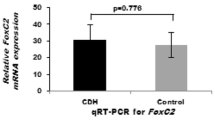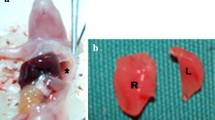Abstract
Purpose
Despite remarkable progress in resuscitation and intensive care, the morbidity and mortality rates in congenital diaphragmatic hernia (CDH) remain high due to severe pulmonary hypoplasia. The pathogenesis of pulmonary hypoplasia associated with CDH is still not clearly understood. Pulmonary parathyroid hormone-related protein (PTHrP) is expressed in the type II epithelial cells and stimulates surfactant production by a paracrine feedback loop regulated by PTHrP receptor (PTHrP-R), which is expressed in the mesenchyme, during terminal airway differentiation. It has been reported that PTHrP knockout and PTHrP-R null mice both exhibit pulmonary hypoplasia, disrupting alveolar maturation before birth. We designed this study to test the hypothesis that gene expression of PTHrP and PTHrP-R is downregulated in the late stages of lung morphogenesis in the nitrofen-induced hypoplastic lung.
Methods
Pregnant rats were exposed to either olive oil or nitrofen on day 9 of gestation (D9). Fetal lungs were harvested on D15, 18, and 21 and divided into three groups: control, nitrofen without CDH [CDH(−)], and nitrofen with CDH [CDH(+)] (n = 8 at each time point for each group, respectively). Total mRNA was extracted from fetal lungs and mRNA expression of PTHrP and PTHrP-R was analyzed by real-time RT-PCR and the significant differences between the groups were accepted at P < 0.05 by statistical analysis. Immunohistochemical studies were also performed to evaluate PTHrP and PTHrP-R protein expression at each time point.
Results
Pulmonary mRNA expression of PTHrP-R was significantly decreased in both nitrofen groups [CDH(−) and CDH(+)] compared to controls at D18 and 21. The mRNA level of PTHrP was significantly decreased at D21 in both nitrofen groups compared to controls. Immunoreactivity of PTHrP and PTHrP-R at D18 and 21 was diminished in the distal epithelium and in the mesenchyme, respectively, in the nitrofen-induced hypoplastic lung compared to control lungs. There were no significant differences in both gene/protein expression of PTHrP and PTHrP-R on D15.
Conclusion
Downregulation of PTHrP and PTHrP-R gene expression during late lung morphogenesis may cause pulmonary hypoplasia in the nitrofen CDH model, disrupting alveolar maturation and surfactant production by interfering with mesenchymal–epithelial interactions.




Similar content being viewed by others
References
Colvin J, Bower C, Dickinson JE et al (2005) Outcomes of congenital diaphragmatic hernia: a population-based study in Western Australia. Pediatrics 116(3):e356–e363
Doyle NM, Lally KP (2004) The CDH Study Group and advance in the clinical care of the patient with congenital diaphragmatic hernia. Semin Perinatol 28(3):174–184
Gosche JR, Islam S, Boulanger SC (2005) Congenital diaphragmatic hernia. Am J Surg 190(2):324–332
Montedonico S, Nakazawa N, Puri P (2008) Congenital diaphragmatic hernia and retinoids: searching for an etiology. Pediatr Surg Int 24(7):755–761
Noble BR, Babiuk RP, Clugston RD et al (2007) Mechanisms of the congenital diaphragmatic hernia-inducing teratogen nitrofen. Am J Physiol Lung Cell Mol Physiol 293(4):L1079–L1087
Doi T, Sugimoto K, Puri P (2009) Up-regulation of COUP-TFII gene expression in the nitrofen-induced hypoplastic lung. J Pediatr Surg 44(2):321–324
Wysolmerski JJ, Stewart AF (1998) The physiology of parathyroid hormone-related protein: an emerging role as a developmental factor. Annu Rev Physiol 60:431–460
Hastings RH, Duong H, Burton DW et al (1994) Alveolar epithelial cells express and secrete parathyroid hormone-related protein. Am J Respir Cell Mol Biol 11(6):701–706
Lee K, Deeds JD, Segre GV (1995) Expression of parathyroid hormone-related peptide and its receptor messenger ribonucleic acids during fetal development of rats. Endocrinology 136(2):453–463
Torday JS, Rehan VK (2002) Stretch-stimulated surfactant synthesis is coordinated by the paracrine actions of PTHrP and leptin. Am J Physiol Lung Cell Mol Physiol 283(1):L130–L135
Torday JS, Sun H, Wang L et al (2002) Leptin mediates the parathyroid hormone- related protein paracrine stimulation of fetal lung maturation. Am J Physiol Lung Cell Mol Physiol 282(3):L405–L410
Rubin LP, Kovacs CS, De Paepe ME et al (2004) Arrested pulmonary alveolar cytodifferentiation and defective surfactant synthesis in mice missing the gene for parathyroid hormone-related protein. Dev Dyn 230(2):278–289
Brandsma AE, ten Have-Opbroek AA, Vulto IM et al (1994) Alveolar epithelial composition and architecture of the late fetal pulmonary acinus: an immunocytochemical and morphometric study in a rat model of pulmonary hypoplasia and congenital diaphragmatic hernia. Exp Lung Res 20(6):491–515
Ramirez MI, Chung UI, Williams MC (2000) Aquaporin-5 expression, but not other peripheral lung marker genes, is reduced in PTH/PTHrP receptor null mutant fetal mice. Am J Respir Cell Mol Biol 22(3):367–372
Karperien M, van Dijk TB, Hoeijmakers T et al (1994) Expression pattern of parathyroid hormone/parathyroid hormone related peptide receptor mRNA in mouse postimplantation embryos indicates involvement in multiple developmental processes. Mech Dev 47(1):29–42
Shannon JM (1994) Induction of alveolar type II cell differentiation in fetal tracheal epithelium by grafted distal lung mesenchyme. Dev Biol 166(2):600–614
Suen HC, Catlin EA, Ryan DP et al (1993) Biochemical immaturity of lungs in congenital diaphragmatic hernia. J Pediatr Surg 28(3):471–475
Utsuki T, Hashizume K, Iwamori M (2001) Impaired spreading of surfactant phospholipids in the lungs of newborn rats with pulmonary hypoplasia as a model of congenital diaphragmatic hernia induced by nitrofen. Biochim Biophys Acta 1531(1–2):90–98
Alcorn D, Adamson TM, Lambert TF et al (1977) Morphological effects of chronic tracheal ligation and drainage in the fetal lamb lung. J Anat 123(Pt3):649–660
Umenishi F, Carter EP, Yang B et al (1996) Sharp increase in rat lung water channel expression in the perinatal period. Am J Respir Cell Mol Biol 15(5):673–679
Takayasu H, Nakazawa N, Montedonico S et al (2007) Reduced expression of aquaporin 5 water channel in nitrofen-induced hypoplastic lung with congenital diaphragmatic hernia rat model. J Pediatr Surg 42(2):415–419
Author information
Authors and Affiliations
Corresponding author
Rights and permissions
About this article
Cite this article
Doi, T., Lukošiūtė, A., Ruttenstock, E. et al. Disturbance of parathyroid hormone-related protein signaling in the nitrofen-induced hypoplastic lung. Pediatr Surg Int 26, 45–50 (2010). https://doi.org/10.1007/s00383-009-2506-8
Published:
Issue Date:
DOI: https://doi.org/10.1007/s00383-009-2506-8




